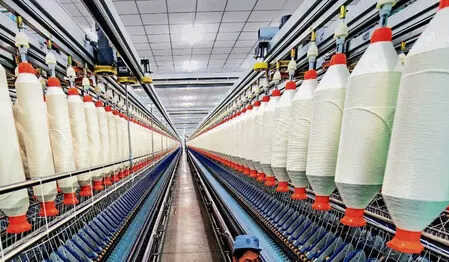Indian textile exporters are bracing for a significant blow as the U.S. imposes steep 50% tariffs, potentially impacting nearly a quarter of India’s textile exports. Order cancellations have already begun, but the government’s extension of duty-free cotton imports until December 31st offers some relief.
The Loom Beckons: Navigating US Tariffs on Indian Textiles
The global marketplace is a complex tapestry, woven with threads of trade agreements, fluctuating economies, and, yes, the occasional tariff. For India’s vibrant textile industry, a sector steeped in history and innovation, the latest developments across the Pacific are causing a ripple effect that could reshape its immediate future. Specifically, looming US tariffs are poised to impact a significant portion – roughly 25% – of India’s textile exports over the coming months. Let’s unravel what this means for businesses, artisans, and the Indian economy as a whole.
The news isn’t exactly a bolt from the blue. Trade tensions between the US and various nations have been simmering for some time. However, the specific focus on Indian textiles introduces a new layer of intricacy to the situation. These aren’t just mass-produced synthetics we’re talking about; India’s textile sector is renowned for its handcrafted fabrics, intricate embroidery, and unique regional weaves. From the luxurious silks of Varanasi to the earthy cottons of Gujarat, the industry represents a rich cultural heritage as much as a significant economic driver.
But why textiles? The answer likely lies in a complex interplay of factors, including efforts to protect domestic US textile manufacturers, address trade imbalances, and potentially exert leverage in broader trade negotiations. Regardless of the precise motivations, the impact is undeniable. A quarter of Indian textile exports heading to the US will now face increased costs, making them less competitive in the American market.

Understanding the Potential Repercussions of US Tariffs
What does this actually translate to on the ground? For starters, Indian textile exporters will likely see a reduction in profit margins. They may need to absorb some of the tariff costs themselves to remain competitive, cutting into their earnings. Alternatively, they could pass the increased costs onto US buyers, potentially leading to a decrease in demand for Indian textiles.
Smaller businesses and artisans, who often lack the resources to navigate complex trade regulations and absorb financial shocks, are particularly vulnerable. Many rely heavily on exports to the US market, and a sudden increase in costs could threaten their livelihoods. It’s a scenario that calls for proactive measures to support these vital contributors to the Indian textile landscape.
Furthermore, the tariffs could have a cascading effect on related industries, such as dyeing, printing, and garment manufacturing. The entire supply chain is interconnected, and disruptions in one area can quickly spread throughout the system. This underscores the need for a holistic approach to mitigating the impact of the tariffs. Perhaps diversification into new markets and developing innovative textile blends could provide alternative avenues for growth. Explore more about innovative approaches to global trade on our site.
Adapting to the New Reality: Charting a Path Forward
So, what can be done? The Indian government and textile industry stakeholders need to work together to develop a comprehensive strategy to address the challenges posed by the US tariffs. This might involve exploring alternative export markets, such as Europe, Asia, and Latin America. Diversifying beyond the US is crucial for long-term sustainability.
Another key strategy is to focus on enhancing the competitiveness of Indian textiles. This could involve investing in technology upgrades, improving production efficiency, and promoting sustainable manufacturing practices. By offering high-quality, ethically produced textiles, India can differentiate itself in the global market and maintain its competitive edge.
Moreover, actively engaging with US trade officials to negotiate more favorable terms is essential. Open communication and a willingness to find mutually beneficial solutions can help de-escalate trade tensions and create a more stable trading environment. Perhaps highlighting the cultural significance and unique artistry of Indian textiles could sway perceptions and foster greater understanding.
Weaving a Stronger Future for Indian Textiles
The imposition of US tariffs on Indian textiles undoubtedly presents a challenge. However, challenges also create opportunities for innovation, adaptation, and resilience. By embracing proactive strategies, investing in competitiveness, and seeking new markets, the Indian textile industry can weather this storm and emerge even stronger. The loom of the future beckons, and it’s up to the industry to weave a vibrant and sustainable tapestry for generations to come.







